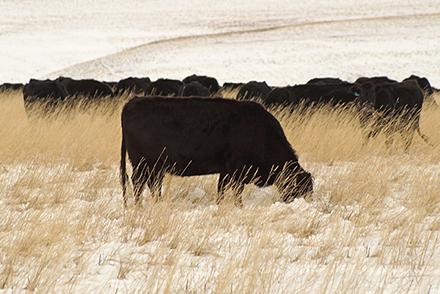Behold, the Power of Grass

Cattle graze on forage cultivated to survive cold temperatures. (Photo by Kevin Jensen, ARS)
Don’t Overlook the Importance of What’s Underfoot
Sometimes the most important things are so close to us that we don’t even notice them. Sometimes they’re even right underfoot. Case in point: grass.
“It’s only grass?” asked Kevin Jensen, geneticist at ARS’s Forage and Range Research Laboratory (FRRL) in Logan, UT. “Try to imagine life without grass: There would be no functioning ecosystems, and quality forage would be lacking; thus, wildlife and livestock would not survive.”
In addition, there would be a significant increase in erosion, invasive weeds, and temperatures, as well as reduced water quality and soil organic matter. As a result, economic sustainability would decrease. In other words, it’s hard to imagine surviving without grasses, much less successfully raising crops.
Fortunately, Jensen and others at the FRRL are working to keep grasses strong. “I use traditional breeding methods to develop new grass varieties that are better adapted to regions that experience increased drought, temperature, and salinity,” he said. “These plant materials are used to reseed these harsh sites and also regions that have been disturbed by wildfires.”
While the effects of climate change have been in the news frequently in the past several years, FRRL has been working on improving grasses since the 1950s. In that time, they’ve developed more than 40 cultivars. According to Jensen, 30-45% of the seed used to reseed after wildfires on public lands are plant materials developed at FRRL.
The process, he said, begins with identifying the trait of interest, such as drought tolerance. From there, researchers must find plants that have the genetic variations they need, and then establish field nurseries to measure the viability of those materials in real-world conditions. Plants that measure up are then cross-bred and put to the test again and again, until a hybrid that researchers want begins to sprout. Each cycle, he said, can take up to 4 years.
The process could take longer, but FRRL uses several modern biotechnology methods to improve the efficiency of traditional breeding. For instance, polymerase chain reaction allows scientists to make millions of copies of a specific portion of DNA, such as a segment that allows for salt tolerance, so that they can study it in detail.
FRRL has over 20 active sites across the western United States, and it takes advantage of that access to study regional variation. Before plants are released, they are evaluated for their ability to adapt to the region, to become the dominant species, and more. If a plant appears to have negative characteristics, FRRL does not release it.
“The goal of this research is to increase grass establishment and persistence while increasing high quality forage for livestock and wildlife,” Jensen said. “We recently helped a rancher in Montana increase his forage base for year-round grazing. The rancher said he didn’t have to sell any cows that year, which is big because some operations have to sell up to 40% of their herd due to lack of forage. Hopefully, these plants will provide a more stable source of forage as environmental factors change.
“I enjoy plant breeding, but the most gratifying aspect is when you can help a rancher, farmer, or land manager improve their operation by using the new plant materials and protocols,” he said. “The research itself is of no value if it doesn’t help someone.” – By Scott Elliott, ARS Office of Communications.
You May Also Like

